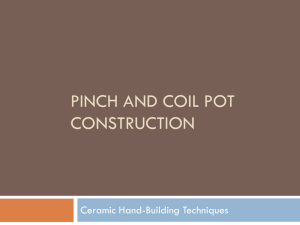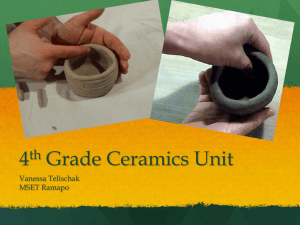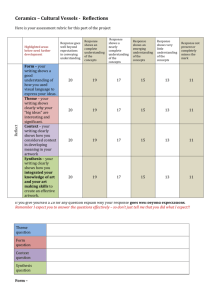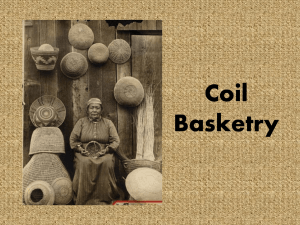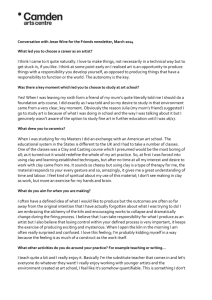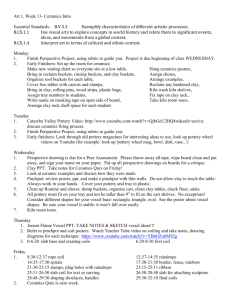Ceramics, Beginning, Grades 9-12
advertisement
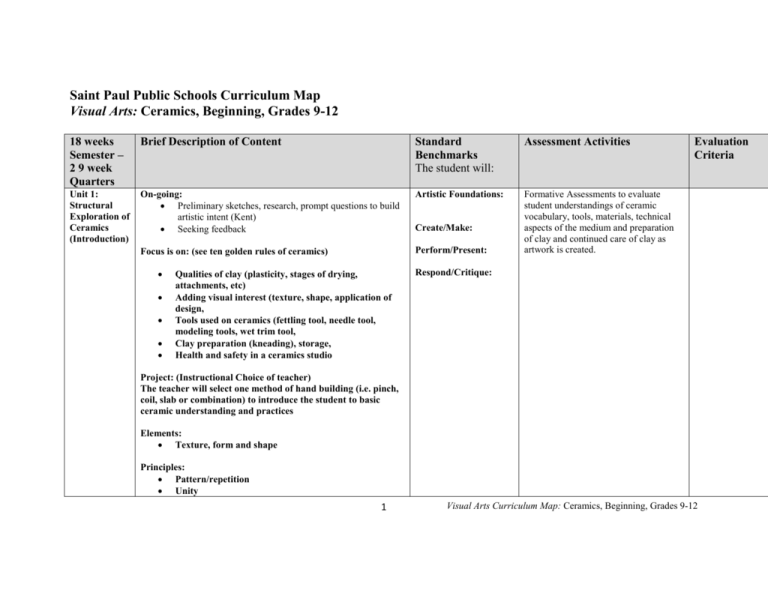
Saint Paul Public Schools Curriculum Map Visual Arts: Ceramics, Beginning, Grades 9-12 18 weeks Semester – 2 9 week Quarters Brief Description of Content Standard Benchmarks The student will: Assessment Activities Unit 1: Structural Exploration of Ceramics (Introduction) On-going: Preliminary sketches, research, prompt questions to build artistic intent (Kent) Seeking feedback Artistic Foundations: Focus is on: (see ten golden rules of ceramics) Perform/Present: Formative Assessments to evaluate student understandings of ceramic vocabulary, tools, materials, technical aspects of the medium and preparation of clay and continued care of clay as artwork is created. Qualities of clay (plasticity, stages of drying, attachments, etc) Adding visual interest (texture, shape, application of design, Tools used on ceramics (fettling tool, needle tool, modeling tools, wet trim tool, Clay preparation (kneading), storage, Health and safety in a ceramics studio Create/Make: Evaluation Criteria Respond/Critique: Project: (Instructional Choice of teacher) The teacher will select one method of hand building (i.e. pinch, coil, slab or combination) to introduce the student to basic ceramic understanding and practices Elements: Texture, form and shape Principles: Pattern/repetition Unity 1 Visual Arts Curriculum Map: Ceramics, Beginning, Grades 9-12 Balance Emphasis Technique: Structural Techniques Scoring, slipping Craft Work Structural integrity Surface Treatment Incising Stamping Additive and Subtractive Artist(s): (teacher may select from following list of exemplars, considering cultural background of students) Maria Martinez Jomon (Japanese style/cultural/historical period) European Ceramic artists Pinch/pot coil Nok heads Local Minnesota (artists such as McKenzie, Christensen, Bresnahan) Unit 2 On-going: Preliminary sketches, research, prompt questions to build artistic intent (Kent) Seeking feedback Focus on: Ceramics skills and techniques: Building techniques – Hand Building Pinch Coil Slab 2 Evaluation Artistic Foundations: Assessment Activity: Stand 1 Benchmark 1 Learning Goals: Benchmark 2 The student will: (extended written (Strand I, Stand 1, Benchmark 2): response) Evaluate in an artist statement Benchmark 4 (selected how principles of visual art are response) used in a coil pot Stand 2 (Strand 1, Stand 1, Benchmark 3): Benchmark 1 Analyze the characteristics of a (performance selected culture as the appear assessment) design sketches for a coil pot Stand 3 Benchmark 2 (extended (Strand 1, Stand 2, Benchmark 1): Visual Arts Curriculum Map: Ceramics, Beginning, Grades 9-12 Wheel Coning Centering Cylinder Bowl Plate Handles & other stuff such as: spouts/lids/lugs Trim Application of Elements & Principles -- Surface Treatment Surface treatment o Texture – additive & subtractive through incising, adding & carving, value in texture, scraffito o Line, shape o Burnishing o Color/value o Pattern/repetition/rhythm/visual movement Form Balance – symmetrical/asymmetrical Glazing Low, mid and high Under glazes, slips, stains Terra Siguilata Dipping Brushing Pouring Spraying Splattering Wax resist written response) Create/Make: Stand 1 Benchmark 1 (extended written response) Benchmark 2 (performance and extended written response) Benchmark 3 (extended written response – sketch for example with oral presentation or written statement) Respond/Critique: To be developed Explain in an artist statement how the materials and techniques of coil construction are used to support an artistic purpose (Strand II, Stand 1, Benchmarks 1, 2, 3): The student will: Create a ceramic pot using coil construction to express a cultural influence Revise a coil pot design based on student/teacher critique and feedback Justify in an artist statement how visual arts principles are used to express a cultural influence in a coil pot Coil Pot Influenced by Cultural Source: Create a coil pot with a slab base, that starts at the base, becomes wider at least once, and then narrows to the top Describe the use of visual arts principles in an artist statement (See assessment detail for more complete description of activity) Assessment Products: Coil Pot Design Sketch and Plan Artist Statement Tech & Skills Projects (for example) basic skills o attachment relief draping for slab building 3 Visual Arts Curriculum Map: Ceramics, Beginning, Grades 9-12 molds sculptural wheel Skill & Tech Design through intention Planning, changing & revising Create, execute Reflecting evaluating & critique Projects: Artistic Foundations: A day to two weeks. 2:1 Integrate tools, techniques & materials of hand built ceramics PINCH Create/Make: Pinch – Lisa: Focus on learning to make attachments. Students pinch Perform/Present: on first day, then add feet and lip (feet, body, lip & ?). Orientation to clay classroom facilities and processes. Respond/Critique: Students make “creature shakers” from two pinch pots. Trouble shooting for thickness, hollows, air bubbles. Students do skipping and scoring, then slips and under glazes and firing. (hardness of clay: wet, leather hard . . . ) Clay warm-ups Pinch – Randy (couple of days): Kids oriented to room then in groups of three make three-part piece: form, lid, something 4 Visual Arts Curriculum Map: Ceramics, Beginning, Grades 9-12 inside. Exploratory about finding problems with working. Students watch each other to be aware of what they are finding about what works and what doesn’t work. Pinch – Kent: Imaginary Window Creature – 1 lb. of clay (one scoop of clay) Practice using clay to understand weight of one hand-scoop. Processes for clay class-room. Selfsupporting, appropriate for school, hollow out. Creative in concept and design. Identify with marks. Evaluative Criteria (done with a partner): Are all seams joined correctly? Any parts to improve? Expressive mood? Emotion evoked? Why? What content or idea does creature convey What grade would you give it and why? Once bisque, students glaze in eight glazes – 5 Visual Arts Curriculum Map: Ceramics, Beginning, Grades 9-12 experiment. (logging possibilities) Pinch – Tom Pug machine – long tubes of clay. Start with a lb. of clay – one scoop. Pack clay into ball with force. Start with a pinch and maintain thumb-width opening. Feel of clay, cleaning up, abating dust. Students given shelves for future work. Students encounter their dried clay and how to maintain workability. Recycling used clay – not disposed of. Orientation to the room and flexibility of clay process. Also workable pinch whistles. Pinch – Susan (first three weeks): Ocarina pinch. Pinch pot folded over into “taco” shape. They refer to detailed sketch of animal. Add texture to animal. Close up and add holes. May include attachment. Slipping and scoring to add details: sockets, lids, scoring and slipping. COILS Susan – coil pot with slab bottoms. Story box – Tom Pinch Pot - Susan Ocarina – Susan Sculpture in Round - Relief 6 Visual Arts Curriculum Map: Ceramics, Beginning, Grades 9-12 Randy: 3 projects in 9 weeks: slab, coil & wheel Lisa: adv. Wheel Susan & Tom: Carving, incising into surface against contrasting clay body Lisa: demonstrations along the way Expectations of accumulation of skill and knowledge: SLAB Lisa – slab construction (three week). Two major slab constructions. Mask: roll a slab of well-wedged clay. Use techniques of rolling slabs. Draping slab and adding detail. Introduce slides of world mask traditions. Functions of masks, identity. Brainstorm about mask forms. Examine decorative and functional purposes of masks. Three dimensionality built up from slab. Produce 5 detail sketches. Pick one and analyze character – emotion. Begin construction with draping and building up. Body part construction: eyes, nose, mouth. Age and emotion through mask elements. Exaggeration explored. Texture building, then color use for emotion and emphasis. Elaborating mask with accessories and details. Finish with holes and wire mounting. Foundations: 1.1 1.2 2:1 Integrate tools, techniques & materials of hand built ceramics Create/Make: 1:1 Perform/Present: 1:2 Respond/Critique: Lisa – Tea Pot. Create three-dimensional attaching. Working with slabs well, seams of attachments to determine what works well. Introduce world tea pot traditions. Four parts of tea pot. Pre-film tea pot question. Describe four parts of pot and draw examples. Students see video of tea pot styles (100’s of images) functional to 7 Visual Arts Curriculum Map: Ceramics, Beginning, Grades 9-12 fanciful. Student write about what they learned and their questions. Students begin with three mini-tea pots. Student pick one of series to show and have critique. Strengths and areas for improvement discussed. Student plan large tea pot and learn slab cut out process using templates. Round templates explored. Construction of spouts, handles and lids. Final glazing, color plan and firing. Student display final teapots, apply ceramics knowledge and vocabulary to critique (what was done well, what could have been done differently), and extensive self-critique (written and verbal). Randy – Slab. Explore history of construction of houses/home. Ancient patterns of dwellings to contemporary architectural/structural styles. Population patterns to human rights background. Slab joining demonstrated. Students draw houses that are adequate for basic human needs. Go for surprising design (no mushroom houses). Structure is height of piece of paper (11” high). Students execute design using a rubric and write artist statement. Additive and subtractive techniques. Vocabulary: Clay defined: leather hard, bone dry, bisque, glaze, glazeware, slip and score, houses and homes Resources: Web sites about structure – historical www.library.thinkquest.org/ - Google: history of houses/homes Christopher Alexander Kent – Tile Project (three to four days 5lbs of clay) Student create tile with imagery in relief sculpture of personal 8 Visual Arts Curriculum Map: Ceramics, Beginning, Grades 9-12 belief. (NPR This I Believe program) “This I Believe Relief” Visual depiction of belief. Not text or commonly available symbols. 6” X 6” minimum dimensions. A variety of textures (excluding canvas textures). Relief carving demonstrated. Students follow a planning guide. Passion and belief distinguished. Border with pattern that integrates with design. Uses student exemplars. Dry on paper towel/newspaper on board. Lay bag on top of tile for two days. Third day bags removed and dry by day 5. Fire and glaze one color at a time. Or, thinned tempera paint (like stain) and shellac. Vocabulary: visual sculpture, pattern, slow dry . . . Tom – Major quarter project – Build Container of Unusual Design Story Box – Making two separate parts that fit together. Density a concern. Box has more than six sides, a lid that fits, and a meaningful quoted phrase on outside (literacy element), a foot to prevent kiln breakage. Phrase needs to show movement on piece. Students apply techniques so slab is workable. 64 cubic” on inside, measurement process reviewed for student success. Height, width and depth reviewed. Construct with slabs, or collection of coils. Students cut and join with skill. Styles of lids/tops examined (see Tom’s handout). Additive pieces and textures possible. Incisions need to be deep enough so glaze won’t obscure. Clean glaze. Students defend project. Artists statement at end, with picture to complete project. Students use rubric to score their work. Susan – Box (or jar) Students create a box relating design of lid to texture/pattern on box, and/or incorporating a Pop Art style. Draw a design after Pop Art style is explained. Student read about slab building and experience teacher demo of construction techniques. Students draw 9 Visual Arts Curriculum Map: Ceramics, Beginning, Grades 9-12 design from two different angles in 3-dimensional way. Students grade themselves using rubric and write about success of their piece. Susan – Relief Postcard Students refer to postcards about locations and personal memories and apply slab construction/relief techniques. 5”X7”X 5/8” thick. Students refer to landscape background ideas: foreground, middle ground and background to organize relief work. Depth and levels of detail at each depth. Students conduct self-evaluation using rubric and write about success of their work. Sydney – in Intro to Visual Art. Stitch Slab Box with Lid and Feet – from self-portrait lesson – contour drawing. Self-portrait with string and glue on masonite. Assemble box. Patterning texture onto box – students create unity using golden rectangle self-reference. Uses Mialica colors. Students print their drawing on one side of clay box. Feet and lids. Focus on joinery. TA’s assist by rolling out slabs. Health and safety issues central. Critique in beginning ceramics: Introduce written work: statements about work. Teacher provides questions to inquire about work and statement of peer. Strengths, weaknesses. Critique build from informal to more formal. Present orally once per semester. Informal critiquing leading to culminating group critique process – helps solve schedule challenges. COIL (all slab bases) Lisa – (1 to 2 weeks) Demonstrate and survey kinds of coil pots. Make an 8” coil pot with slab bottom. Students select a form and create it through coil. Explain design source and reason for selection. Areas on pot that you can see coil, others that coil is not visible. Mid-fire glazing (cone 6). 10 Foundations: 1.1 1.2 2:1 Integrate tools, techniques & materials of hand built ceramics Assessment Activity: Create a coil project Coil Project Artist Statement Visual Arts Curriculum Map: Ceramics, Beginning, Grades 9-12 Kent – (lessons on program advocacy) (5 to 7 days) Coil culture project. 8 to 10 lbs of wet clay. Students can extrude or hand roll coils. Demonstrate semi-closed container with personal cultural significance. Kent mediates student responses to cultural pottery forms – i.e., cultures without ceramic tradition. Encourages flexibility of cultural selection (see MIA East Asia collection of resources). Students research pottery of cultural identity (pottery from my culture). Students select stylistic pottery elements and create a sketch similar to teacher exemplar. Students create a final plan from selected sketch. Students then create a pattern plan from a similar research process. Patterns are applied to selected pot body segment. Glazing process involves terra S. Kent leads study and creates terra S. Vocabulary: coil, coil technique, greenware, terra S (basic glaze form), burnishing, cultural significance, score and slipping, semi-closed form. Create/Make: 1:1 Perform/Present: 1:3 Respond/Critique: Students write an artists statement and critique of work. Randy – Students study Maria Martinez (video?). (2 weeks) Demonstrate coil technique. Students draw out shape: narrow slab base, work out and taper (multiple times possible). Design a visual image of their culture/heritage or contemporary popular culture. Smooth off coils (inside and outside). Belly, shoulder, neck and lip body parts examined. Apply a pattern design encircling the entire piece (cultural element in the pattern or separate). Piece should be 8” to 12” high. (dares kids to exceed his height exemplar). Vocabulary: Tom – same as Kent and Randy stresses anatomy of pot: foot, belly, shoulder, neck and mouth. Motif pattern circles piece. Symmetry in pattern. Susan – Students study Maria Martinez. Introduces sewing of coils (sewing clay – same body of clay and time period – slipping and scoring connecting later). Students create pot in reference to three drawings of three different forms. Student comes up with geometric 11 Visual Arts Curriculum Map: Ceramics, Beginning, Grades 9-12 design corresponding to form of pot. Teacher approves student selected design (gatekeeping) and demos coil building. Students build 5” high pot (at least) that fits form on drawing. Starts with slab base. Smoothes inside and outside. Burnish after overnight drying using tool. 1 to 2 days on burnishing, then design plan is incised into piece. Designs adjusted to accommodate final form. Apply pattern with MKM decorating tool. Sydney – Self-portrait, realistic observation, photograph student from all four sides, printed out and used as source for coil. Portrait matches side to side and done in red clay. Traditional sculpture, smoothed coils. Tom – (3 to 4 weeks) Slab base piece. Students practice coiling, blending, paddling, smoothing with a rib. Student roll slab for base. Practice rolling coil and using with knowledge of drying limitations. Build a straight walled cylinder. 2” taller than it is wide. Paddling, and using a rib tool to refine coil piece. Critiqued for imperfections using a rubric with exemplars of each level of quality. Students use a banding wheel to keep consistent shape. Once created, students change their cylinder, incise, add clay by scoring and slipping (no handles or spouts), cut at least 3 holes (negative space), 3 kinds of texture. No words or numbers. Can orient the cylinder flexibly. Students glaze or plain fire then paint (acrylic). Student reflect on changes if they created another. Critiqued using a rubric. Students write a statement of intent. 12 Visual Arts Curriculum Map: Ceramics, Beginning, Grades 9-12 WHEEL Kent – Wheel lesson (1 week) – (technique lesson – no final finished product) 6 cylinders of 1 lb of clay. Students cut cylinders up middle and evaluate the profile view of the cylinder. Each cylinder is on 50 point scale: No outside flange Bottom is even Heights of two wall are equal Thickness is wall is consistent Corner is clean (nice L shape) Rim is trimmed evenly Walls are straight and of equal thickness Students can replace low scored cylinders with better work Wheel operation and physical demands: balance, kick and fine motor, active muscles and anchoring (support), muscle memory/patterning; mental demands: patience, concentration and pause. Tom adds: throwing unified through one piece of clay. Kent adds, pottery wheel is a tool in the hands of a skilled thrower (I have to operate it correctly for it to work). Vocabulary: wedging, centering, opening up, draw back, compress the bottom, compress the rim (sponge used), pulling up, final forming (wet tooling), trim and cut. Susan adds coning the clay. 13 Visual Arts Curriculum Map: Ceramics, Beginning, Grades 9-12 Tools: Rib tool, wooden knife, needle tool and sponge. Cylinder is most basic form – other forms result from cylinder. Randy – Art history on Bernard Leach and Shoji Hamada, Warren MacKensie. Throw 6 pieces and teacher/students look for same quality features as listed under Kent. Butterfly images for shaping with hands. Alligator and caterpillar image for compressing rim. Sydney – ask about wheel techniques CUPS, BOWLS AND PLATES Handles, lids and spouts Kent – Students encouraged to make pieces they will use. Mug, glass and yanomies (traditional Japanese tea cup) Students make one of each form. 1 lb of clay. Students put a handle on the mug, a foot on the yanomie and glass is straight cylinder. Teacher demonstrates technique and students practice until they have satisfactory completion. Pattering and decoration added by student choice. Same criteria for good work as cylinder work. 14 Visual Arts Curriculum Map: Ceramics, Beginning, Grades 9-12 Bowls – students create 3 bowls 1.5 lbs of clay. Teacher demonstrates bowl techniques and styles of bowls. Fruit bowl (low and wide), cereal bowl (as wide as deep), mixing bowl (taller and narrower). Trim a foot on each bowl. Similar evaluation and elaboration options for students. Throw 1, 3 lb clay plate, trim foot on plate. Students use bats on wheel. Similar evaluation and student options for elaboration. 2nd Quarter? Design and Expression form (sculptural) & function functional & non-functional hand built & wheel built Susan -- Surrealist interior and exterior piece (2.5 to 3 weeks) – Design a room dealing with inside and outside. Roots of surrealism in unconscious processes (dreams) draw from inside and outside to plan. Use relief element on every wall (inside and outside). Add a free-standing element on the floor. Relate inside and outside through: theme, elements that cross-over, visual movement inside and outside, etc. No smaller than 4” walls, 5” recommended. Glazing and firing is student choice. Tom – Reference the “changed coil cylinder” project. Kent and Randy – Reference “coil culture” project Kent – tile project 15 Visual Arts Curriculum Map: Ceramics, Beginning, Grades 9-12 16 Visual Arts Curriculum Map: Ceramics, Beginning, Grades 9-12
